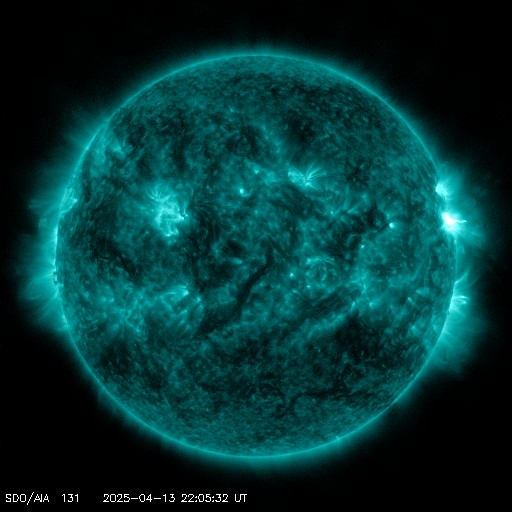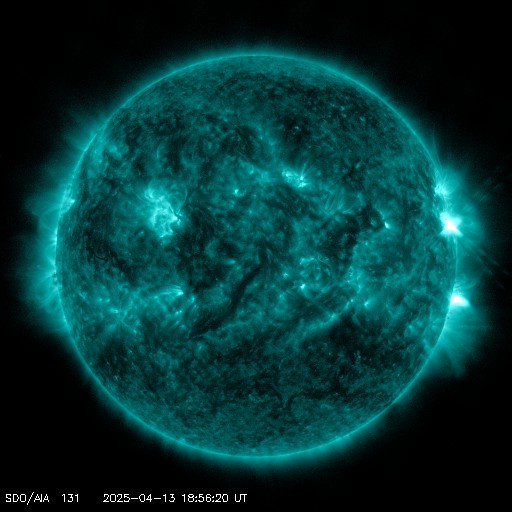Viewing archive of Friday, 6 November 2015
Daily bulletin on solar and geomagnetic activity from the SIDC
Issued: 2015 Nov 06 1230 UTC
SIDC Forecast
Solar flares
C-class flares expected, (probability >=50%)
Geomagnetism
Minor storm expected (A>=30 or K=5)
Solar protons
Quiet
| 10cm flux | Ap | |
|---|---|---|
| 06 Nov 2015 | 112 | 012 |
| 07 Nov 2015 | 115 | 034 |
| 08 Nov 2015 | 117 | 023 |
Bulletin
No C- or M-class flares have been recorded during the period. NOAA 2445 rounded the northwest limb, while NOAA 2443 continued its decay and magnetic simplification. An active region is rounding the southeast limb, raising the x-ray background flux but so far without significant flaring activity. A filament near the equator at 50 degrees west erupted between 15:00 and 16:00UT. No earth-directed coronal mass ejections (CMEs) were observed.
C-class flares are expected, with a chance on an isolated M-class flare.
Earth was still under the waning influence of the high speed stream (HSS) of the equatorial coronal hole (CH). Solar wind speed showed a declining trend varying between 570 km/s and its current 460 km/s. Bz varied mostly between -4 and +3 nT, being mostly negative. The interplanetary magnetic field was directed away from the Sun. Quiet to active geomagnetic conditions were observed. A wide positive northern coronal hole (CH) reaching down to +10 degrees latitude has started transiting the central meridian early on 06 November.
Expected geomagnetic conditions range from quiet to active, with minor storming possible on 07 November in response to the expected arrival of the 04 November CME. A major storming episode cannot be excluded. Starting late on 08 November, active to minor storming is possible in response to the arrival of the co-rotating interaction region and HSS associated with the northern CH.
Today's estimated international sunspot number (ISN): 081, based on 14 stations.Solar indices for 05 Nov 2015
| Wolf number Catania | 099 |
| 10cm solar flux | 110 |
| AK Chambon La Forêt | 029 |
| AK Wingst | 020 |
| Estimated Ap | 019 |
| Estimated international sunspot number | 084 - Based on 26 stations |
Noticeable events summary
| Day | Begin | Max | End | Loc | Strength | OP | 10cm | Catania/NOAA | Radio burst types | |
|---|---|---|---|---|---|---|---|---|---|---|
| None | ||||||||||
Provided by the Solar Influences Data analysis Center© - SIDC - Processed by SpaceWeatherLive
All times in UTC
Current data suggests there is a slight possibility for aurora to appear at the following high latitude regions in the near future
Gillam, MB, Iqaluit, NUNuuk
Reykjavik
Latest news
Latest forum messages
Support SpaceWeatherLive.com!
A lot of people come to SpaceWeatherLive to follow the Sun's activity or if there is aurora to be seen, but with more traffic comes higher server costs. Consider a donation if you enjoy SpaceWeatherLive so we can keep the website online!

Latest alerts
Sunday, 13 April 2025
22:21 UTC - Solar flare
Moderate M1.66 flare from sunspot region 4055
22:03 UTC - Radio Blackout
Minor R1 radio blackout in progress (≥M1 - current: M1.01)
20:48 UTC - Hemispheric Power Index
The OVATION model predicts the Hemispheric Power Index to reach 50GW at 21:39 UTC
19:09 UTC - Solar flare
Moderate M3.24 flare from sunspot region 4055
18:51 UTC - Radio Blackout
Minor R1 radio blackout in progress (≥M1 - current: M1.07)
Space weather facts
| Last X-flare | 2025/03/28 | X1.1 |
| Last M-flare | 2025/04/13 | M1.6 |
| Last geomagnetic storm | 2025/04/06 | Kp5 (G1) |
| Spotless days | |
|---|---|
| Last spotless day | 2022/06/08 |
| Monthly mean Sunspot Number | |
|---|---|
| March 2025 | 134.2 -20.4 |
| April 2025 | 136.4 +2.2 |
| Last 30 days | 134.2 -8.9 |




